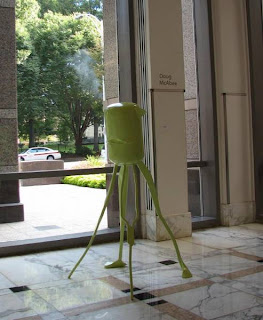Linda Luise Brown, Charlotte Observer, Oct. 24, 2008
Right now the spaces at the Gallery at Carillon are enriched with some fresh-out-of-the-studio contemporary art.
These paintings and ceramics recall the florid colors of the “Fauves,” the abstracted human forms of Willem de Kooning, the meticulous technique of the French “Pointillists.” This current art bears plenty of other references to 19th- and 20th-century art history.
Right now the spaces at the Gallery at Carillon are enriched with some fresh-out-of-the-studio contemporary art.
These paintings and ceramics recall the florid colors of the “Fauves,” the abstracted human forms of Willem de Kooning, the meticulous technique of the French “Pointillists.” This current art bears plenty of other references to 19th- and 20th-century art history.
Of the five artists' work on display, David JP Hooker's multiple-part glazed ceramic construction (it's 8-by-12-feet across a wall) most resembles “Cascade,” Jean Tinguely's permanent installation that dominates the lobby. Though static rather than mobile, Hooker's “Tumblestack IV” promotes unusual juxtapositions, as does Tinguely's work. Hooker, who studied at Winthrop University in Rock Hill, lives in Wheaton, Ill.
But it is the vivid color and loose execution of paintings by Philip Morsberger that will catch your attention.
The huge staring face of the ragged-edged man with the startled cartoon eyes in Morsberger's “Epiphany” is the right scale for the sharp corporate lobby. His lively impasto paintings command their spaces here. Using thickly drawn lines, Morsberger applies abstracted figures of men and dogs, sometimes combined, over a background of splashy scrubbed color painted by the Abstract Expressionist brush load.
The inward-looking, tightly controlled pencil and brushwork of Paul Matheny of Rock Hill makes a good counterpoint to the unleashed mania of Morsberger's brush.
Matheny's small panels are covered with networks of fine lines with some of the spaces filled in with thin layers and thick pinpoints of paint to create the intense “pointillist” appearance. Birds, heads, suns, targets are transformed into a mystical realm of symbols with obscure meanings. In “Seeds,” images of targets form a halo effect around a whitened profile, symbolizing floating thoughts or ideas.
Notably, all eight pieces of Matheny's contain the motif of the silhouetted profile. “Finding Frogmore” features a bottle tree branching from one such head. Dozens of bottles rendered with the inner glow of lapis lazuli float amid stars; the whole surface is rendered with an obsessive texture reminiscent of Arabic or Islamic tile decoration.
Two brightly painted anthropomorphic steel sculptures by Doug McAbee of Spartanburg stand on both sides of the lobby door, acting as otherworldly sentinels.
The work of the solitary woman in the show, Jill Allan of Portland, Ore., is subdued by contrast. Her slab-built earthenware sculptures – two larger-than-life birds nesting among upright wires twisted into spoon shapes –nestle in a quieter corner of the lobby, inviting muted conversation.
The work on view through Jan.16 certainly contains some abstracted characteristics; strictly speaking, however, this is not an abstract show.
Abstract or not, it is a good show, and kudos go to Hodges Taylor Gallery for bolstering the uptown experience with art of good quality.
 "Tumblestack IV"
"Tumblestack IV"David JP Hooker
Glazed Ceramic
Philip Morsberger
Oil on Canvas
Philip Morsberger
Oil on Canvas
Paul Matheny
Acrylic & Graphite on Wood Panel
 "Between"
"Between"Paul Matheny
Acrylic & Graphite on Wood Panel
 "Laura Jean"
"Laura Jean"Doug McAbee
Painted Steel
 "Snowball"
"Snowball"Doug McAbee
Painted Steel

"Chemical Reaction"
Jill Allen
Mixed Media






No comments:
Post a Comment